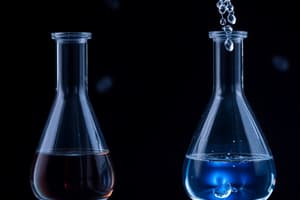Podcast
Questions and Answers
What is the chemical structure of diamond?
What is the chemical structure of diamond?
- C4
- C6
- C2
- C (correct)
What is the location of electrons in an atom?
What is the location of electrons in an atom?
- In the protons
- In shells around the nucleus (correct)
- Outside the atom
- In the nucleus
What is the charge of the nucleus of an atom?
What is the charge of the nucleus of an atom?
- Positive (correct)
- It depends on the element
- No charge
- Negative
What is the classification of oxygen gas?
What is the classification of oxygen gas?
What is the chemical structure of table salt (sodium chloride)?
What is the chemical structure of table salt (sodium chloride)?
What is the number of protons in the atom of Calcium (Ca)?
What is the number of protons in the atom of Calcium (Ca)?
Which element is a non-metal?
Which element is a non-metal?
What is the term for an atom that has gained an electron?
What is the term for an atom that has gained an electron?
What is the atomic symbol for the element Manganese?
What is the atomic symbol for the element Manganese?
Which atoms typically lose electrons?
Which atoms typically lose electrons?
What is the electron configuration of a fluoride ion?
What is the electron configuration of a fluoride ion?
What is the purpose of using Roman numerals when naming a cation?
What is the purpose of using Roman numerals when naming a cation?
What is the chemical symbol for the manganese ion with a charge of 4+?
What is the chemical symbol for the manganese ion with a charge of 4+?
What is the name of the anion with the chemical symbol S2-?
What is the name of the anion with the chemical symbol S2-?
What is the electron configuration of a fluorine atom?
What is the electron configuration of a fluorine atom?
Which of the following is a characteristic of an ion?
Which of the following is a characteristic of an ion?
What type of ion is formed when a metal atom loses electrons?
What type of ion is formed when a metal atom loses electrons?
Which elements are unlikely to form ions?
Which elements are unlikely to form ions?
What is the electron configuration of a sodium ion?
What is the electron configuration of a sodium ion?
What is the process by which anions are formed?
What is the process by which anions are formed?
Match the following atoms with their resulting ions when they gain or lose electrons:
Match the following atoms with their resulting ions when they gain or lose electrons:
Match the following descriptions with the type of ion:
Match the following descriptions with the type of ion:
Match the following elements with the type of ions they can form:
Match the following elements with the type of ions they can form:
Match the following electron configurations with the corresponding atom or ion:
Match the following electron configurations with the corresponding atom or ion:
Match the following processes with the type of ion formed:
Match the following processes with the type of ion formed:
Match the elements with their respective atomic numbers:
Match the elements with their respective atomic numbers:
Match the elements with their classification as metal or non-metal:
Match the elements with their classification as metal or non-metal:
Match the ion formation processes with their descriptions:
Match the ion formation processes with their descriptions:
Match the elements with their atomic symbols:
Match the elements with their atomic symbols:
Match the elements with their special properties:
Match the elements with their special properties:
Match the following cations with their chemical symbols:
Match the following cations with their chemical symbols:
Match the following anions with their chemical symbols:
Match the following anions with their chemical symbols:
Match the following electron configurations with their corresponding ions:
Match the following electron configurations with their corresponding ions:
Match the following types of ions with their characteristics:
Match the following types of ions with their characteristics:
Match the following ions with their names:
Match the following ions with their names:
Flashcards are hidden until you start studying




